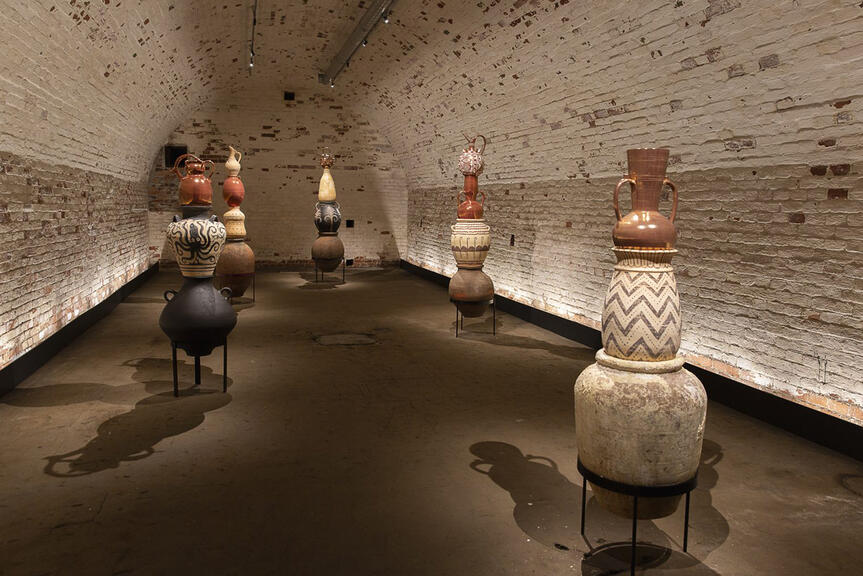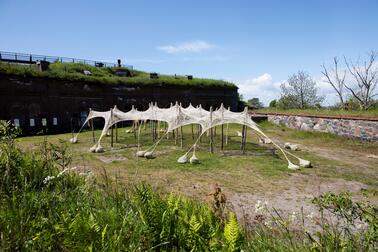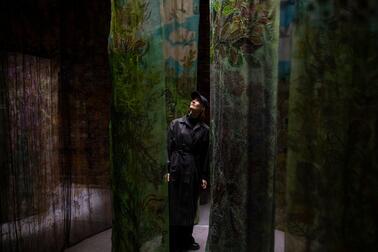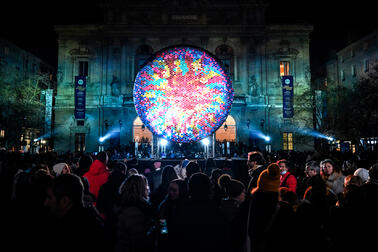
By envisioning various speculative futures, this year’s Helsinki Biennial: New Directions May Emerge brings together artists and collectives to explore alternative ways of living in and understanding the world.
Helsinki Biennial returns for the second time to Vallisaari, a former military island off the coast that is the most diverse natural and recreational destination in the Helsinki archipelago. Fifteen artworks will be situated on the island, both outdoors and within its historical gunpowder cellars.
One of the island destinations is a wooden cabin with watercolour paintings from Suzanne Treister, presenting plans for alternative visions of survival on earth and inhabitation of the cosmos. The paintings are accompanied by a new AR component, which makes the artwork appear to float high in the sky. Jenna Sutela’s interactive artwork likewise creates an ever-emerging soundscape, as a water-filled bronze bowl uses machine learning technology to relay signals from the wider island environment, including sounds from outer space and under the sea.
The Vallisaari component of the second-ever Helsinki Biennial also features interactive and experiential works from Lotta Petronella, Lau Nau and Sami Tallberg, who have created a transdisciplinary artwork focusing on healing, song and nutrition, with a series of performances from a lamenting choir and oracle readings. Danielle Brathwaite-Shirley in turn invites visitors to take part in a role-playing performance event and installation exploring a new mythology for Vallisaari.
Back on land at the HAM Helsinki Art Museum, works by Diana Policarpo, Bita Razavi, Tabita Rezaire, Tuula Närhinen and INTERPRT will take over the large arched halls. Bita Razavi’s participatory sculptural work considers the political and colonial structures of different countries. Diana Policarpo’s installation consists of massive, rock-shaped sculptures with embedded video and sound which investigate how humans treat the world as their property. Tuula Närhinen depicts in her art the river as a cyclical time machine and an archive of human life that is shaped by nature. Tabita Rezaire highlights water’s complex narratives by examining how the submarine fibre optic cables that transfer digital data are layered upon old colonial shipping routes. INTERPRT’s new work is a case study which explores the histories of for example state violence.
The main exhibitions will be complemented by events, performances, workshops and discussions throughout the summer.
Events all around the city
Located in the city’s Market Square, Dineo Seshee Bopape’s new work seeks to find a path to remembering and re-membering through fragmented parts of personal and collective family histories.
Sonya Lindfors’ new collaborative artwork, which can be described as a ‘social choreography’, takes place across several sites around central Helsinki and is in collaboration with BIPOC artists and volunteers.
Created as a collaboration between anthropologists Yen-Ling Tsai and Anna Lowenhaupt Tsing, filmmaker Isabelle Carbonell, and farmer and translator Joelle Chevrier, the Golden Snail Opera is a multispecies enactment of experimental natural history. The opera incorporates percussion from Yilan opera, combining it with the noises of snails, water, birds, and other beings, and will be staged at the Helsinki Central Library Oodi in June and August.
Critical Environmental Data will create six audio stories that listeners can follow across various in-person locations in Helsinki or online. Museum of Impossible Forms will develop for example the Biennial’s discursive program of lectures, screenings, performances. Aalto University students will also organise a series of collective experiences on the Biennial theme, and a website that combines HAM’s collection with machine learning technology will invite users to explore new groupings from the collection based on geolocations and machine-made metrics.
2023 Biennial is even closer to the people
The Mayor of Helsinki, Juhana Vartiainen, is proud of the city’s international Biennial which showcases Helsinki’s cultural richness and spirit to the world.
“This year, Helsinki Biennial will be even closer to the people of Helsinki so that each resident and visitor will be able to experience art and be inspired by it. Art and culture are a great asset and source of pride for us; by bringing them to the heart of the city, we can spark conversations and strengthen community, togetherness and creativity – the very things that Helsinki is built upon,” he said.
Director of the Helsinki Art Museum HAM Arja Miller states that the Helsinki Biennial that has become an intrinsic part of what HAM is: Both internationally ambitious while remaining a truly local event realised through the shared efforts of HAM and the City of Helsinki.
“Global challenges, such as biodiversity loss and the climate crisis, affect us all. In this time, we need fresh ways of understanding, perceiving, and finding answers to difficult questions. Artists have a special skill to give new forms to history, places, feeling, and thought: their artworks can represent the present and create the future, inviting visitors to gain new points of view, insight, and at times, consolation,” she said.
Joasia Krysa, curator of 2023 Helsinki Biennial, elaborates that the event takes its point of departure from the island of Vallisaari, the regenerative energy of multispecies landscapes, and the data which is manipulated by algorithms. It gathers ideas from an eclectic mix of influences – from natural science and cosmology, the supernatural and artificial intelligence, data science and science fiction, the sense-making practices of humans and nonhumans, the actions of sentient and other worldly beings – to identify some of the conditions through which new directions may emerge.
The Helsinki Biennial will continue on the Vallisaari island until 17 September 2023 and at the HAM Helsinki Art Museum until 22 October.


